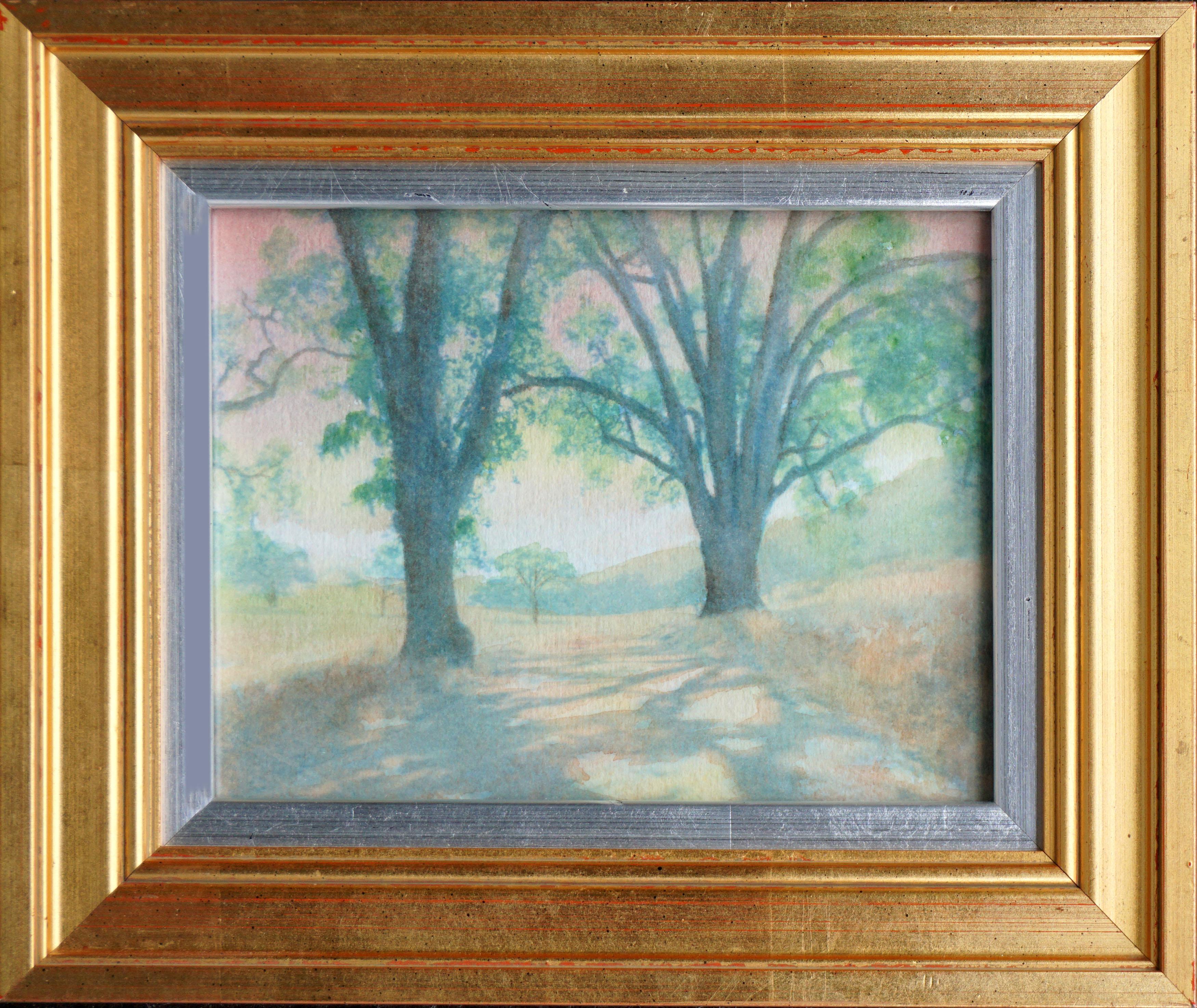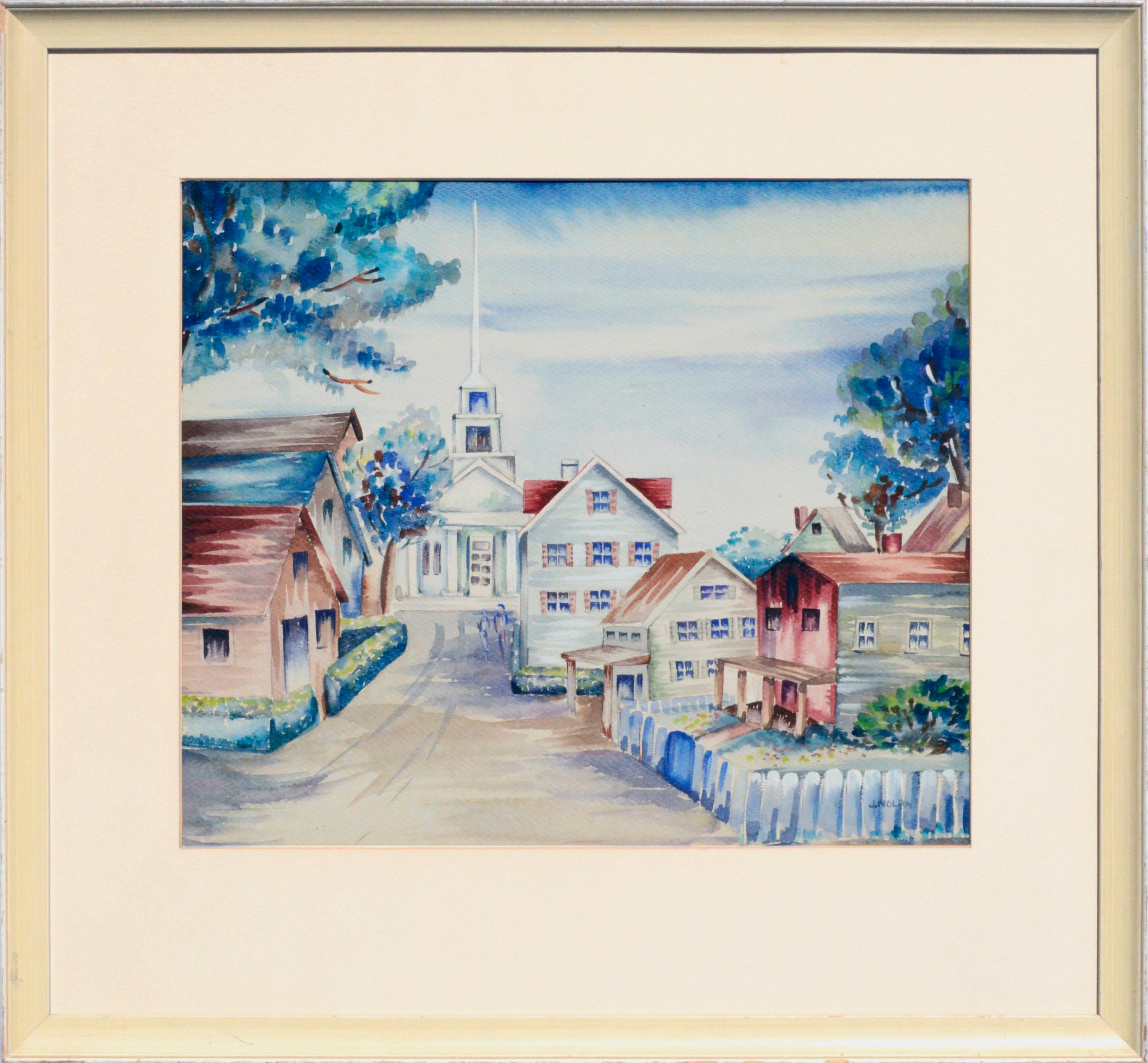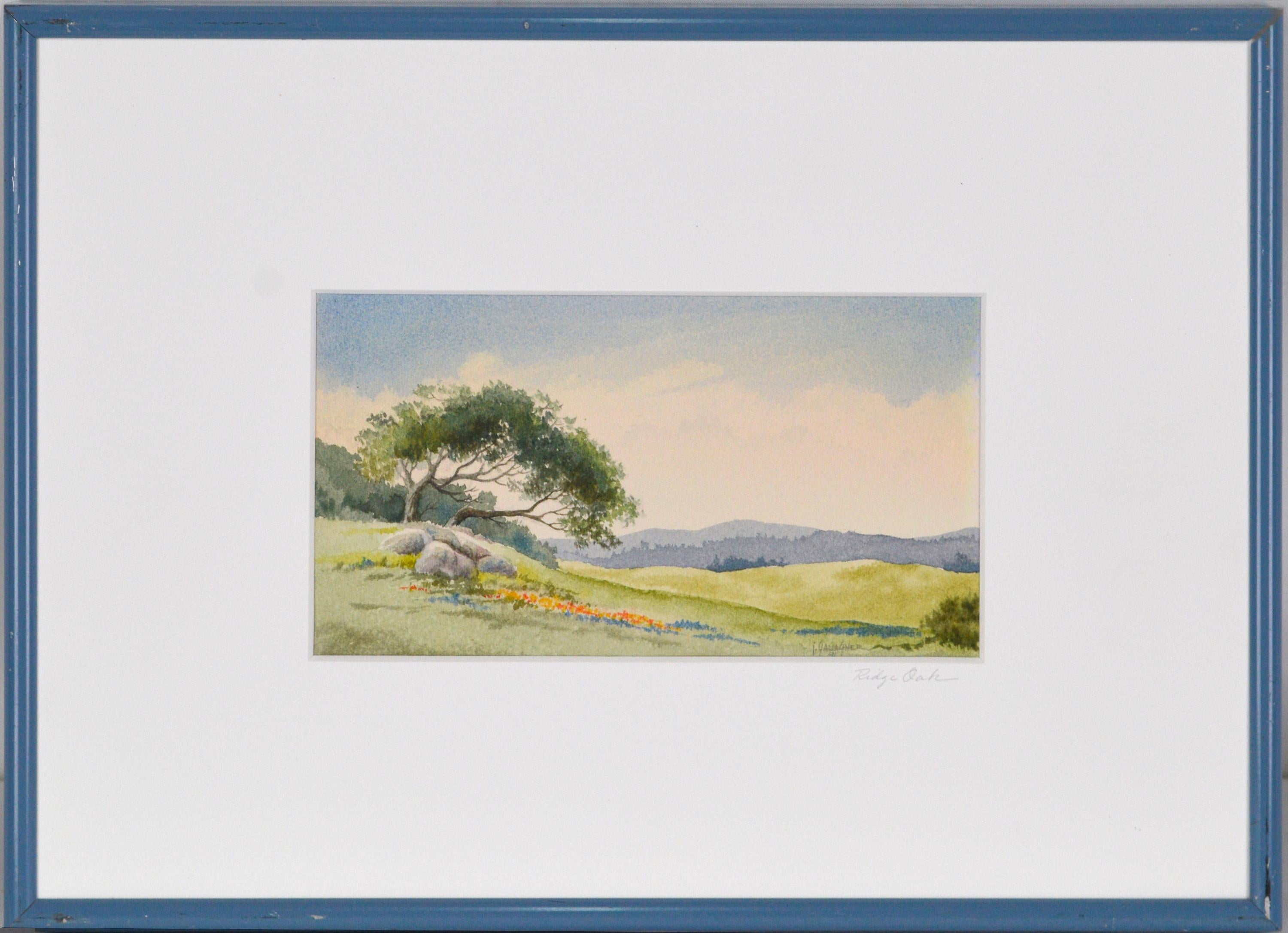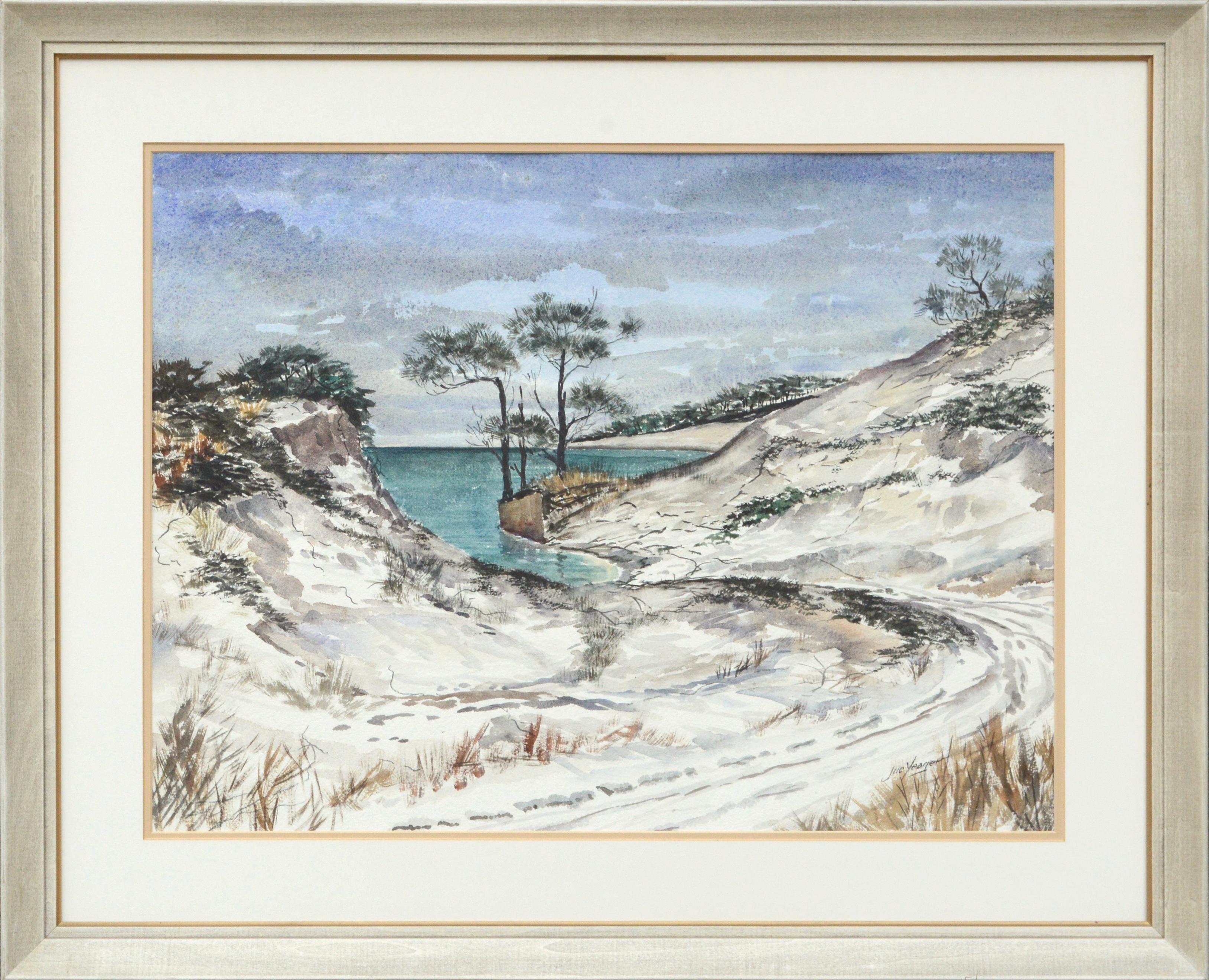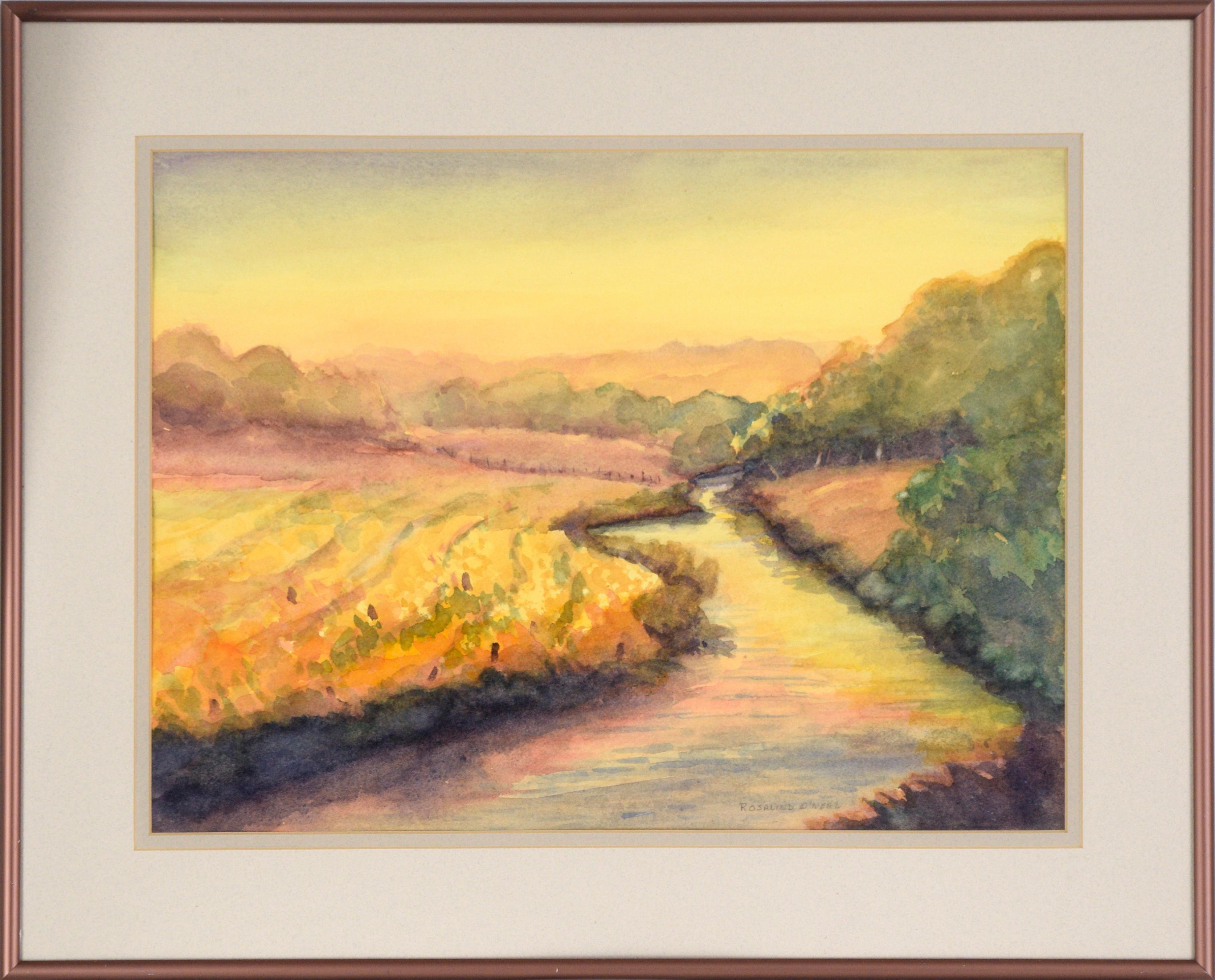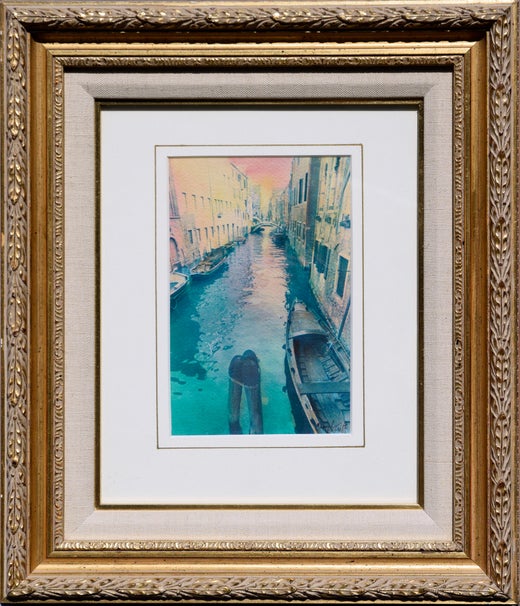Items Similar to "Floating Shadows" - Cyanotype / Watercolor Forest Landscape
Want more images or videos?
Request additional images or videos from the seller
1 of 7
Cheryl Trotter"Floating Shadows" - Cyanotype / Watercolor Forest Landscape 1989
1989
About the Item
Soft watercolor accents add to the beauty of this cyanotype and watercolor landscape of forest trees, titled "Floating Shadows", by Cheryl Trotter (American, 20th century), c. 1980's. Signed lower right "Cheryl Trotter." Displayed in an archival mat and a 1930's period giltwood and linen frame. Image, 7"H x 7"W.
Cyanotype is a photographic printing process (photographic/blueprint process) that produces a cyan-blue print.
Cheryl Trotter, a Pacific Grove artist and fine art photographer, owned and operated the Artist Forum, a Pacific Grove gallery.
- Creator:
- Creation Year:1989
- Dimensions:Height: 16.5 in (41.91 cm)Width: 14.25 in (36.2 cm)Depth: 0.5 in (1.27 cm)
- Medium:
- Movement & Style:
- Period:
- Condition:Age toning and slight foxing to mat. Condition: Good. Previously owned and used, with little or no signs of wear and is in good condition. No structural issues.
- Gallery Location:Soquel, CA
- Reference Number:
Cheryl Trotter
Cheryl Trotter resided in Pacific Grove, California. She was an artist and a fine art photographer. Trotter owned and operated the Artist Forum, a Pacific Grove gallery.
About the Seller
4.9
Platinum Seller
These expertly vetted sellers are 1stDibs' most experienced sellers and are rated highest by our customers.
Established in 1986
1stDibs seller since 2014
2,520 sales on 1stDibs
Typical response time: <1 hour
- ShippingRetrieving quote...Ships From: Soquel, CA
- Return PolicyA return for this item may be initiated within 14 days of delivery.
More From This SellerView All
- "Pathways - Rancho San Carlos" - California Trees LandscapeBy Cheryl TrotterLocated in Soquel, CASoft watercolor and Cyanotype of oak trees at Rancho San Carlos by Cheryl Trotter (American, 20th century). Signed lower right "Cheryl Trotter." Displayed i...Category
1980s American Impressionist Landscape Drawings and Watercolors
MaterialsWatercolor, Laid Paper
- 1930's Milford, CT Landscape -- First Church of Christ CongregationalLocated in Soquel, CA1930's watercolor figurative landscape depicting the First Church of Christ Congregational in Milford, Connecticut by J. Nolan of Providence, Rhode Island (American, 20th Century). S...Category
1920s American Impressionist Landscape Drawings and Watercolors
MaterialsLaid Paper, Watercolor
- "Ridge Oak" Northern Mt Tamalpais California Watercolor 1991Located in Soquel, CA"Ridge Oak" Northern Mt Tamalpais California Watercolor 1991 Perfectly executed plein air watercolor looking out towards Mt. Tamalpais in spring by J. Gal...Category
1990s American Impressionist Landscape Drawings and Watercolors
MaterialsWatercolor, Laid Paper
- Ocean Path Through Sand Dunes - Florida LandscapeBy Joseph YeagerLocated in Soquel, CASerene landscape of a path to the ocean through sand dunes by Joseph Yeager (American, 20th century). Signed "Joe Yeager" in the lower right corner. On verso is written "Gift painted...Category
1970s American Impressionist Landscape Drawings and Watercolors
MaterialsWatercolor, Laid Paper
- Golden Hour at the River - Watercolor Landscape on PaperLocated in Soquel, CAGolden Hour at the River - Watercolor Landscape on Paper Glowing sunset landscape by Rosalind O'Neal (American, b. 1927). A river winds winds towards the viewer, reflecting the glowing sunset. On the left bank, there are rows of crops in yellow and orange. On the right side, trees and shrubs line the bank. In the distance green and golden hills meet the sky. Signed "Rosalind O'Neal" in the lower right corner. Presented in a copper colored frame with a double mat. Frame size: 17"H x 21"W Image size: 12"H x 16"W Rosalind O’Neal (American, b. 1927) was a longtime Ukiah, CA resident and a member of the Mendocino County Art Association. O’Neal was primarily a watercolor artist, focusing on portraits and landscapes, but has also worked in acrylic at times. 1997 - Ukiah Main Office Savings Bank of Mendocino County, Ukiah, CA 2003 - Savings Bank of Mendocino, Ukiah, CA 2004 - Mendocino County Art Association’s Golden Anniversary...Category
21st Century and Contemporary American Impressionist Landscape Drawings ...
MaterialsWatercolor, Laid Paper
- Red Tulips and California Poppies, LandscapeLocated in Soquel, CABrightly colored floral landscape by unknown artist Duane Reid (American, 20th Century). Bold red and orange flowers with green foliage contrast nicely against a blue sky with puffy ...Category
Late 20th Century American Impressionist Landscape Drawings and Watercolors
MaterialsWatercolor, Laid Paper
You May Also Like
- Mother and Children watercolor painting by John E. CostiganBy John CostiganLocated in Hudson, NYPainting measures 22" x 28" and framed 26" x 32" x 2" Hand-signed "J.E. Costigan NA 1952" lower left. About this artist: John Costigan was a self-taught painter distinguished by h...Category
Mid-20th Century American Impressionist Figurative Drawings and Watercolors
MaterialsPaper, Watercolor
- The Rapids (Maine)By John WhorfLocated in Provincetown, MAJohn Whorf, born in 1903, was a talented, opinionated artist who achieved great success at a young age. Encouraged by his artistic father, Whorf studied briefly during his early te...Category
Early 20th Century American Impressionist Landscape Drawings and Waterco...
MaterialsPaper, Watercolor
- Pennsylvania Farmhouse, American Impressionist Landscape, Watercolor on PaperBy Albert Van Nesse GreeneLocated in Doylestown, PA"Pennsylvania Farmhouse" is a beautiful spring landscape with rolling hills and countryside farmhouses. The watercolor on paper is painted by American Impressionist Albert Van Nesse Greene. The painting is a 14" x 19" watercolor on paper, matted, framed under glass, and signed "A V Greene...Category
Early 20th Century American Impressionist Landscape Drawings and Waterco...
MaterialsWatercolor, Archival Paper
- 59th Street Bridge, Pennsylvania Impressionist Watercolor CityscapeBy Walter Emerson BaumLocated in Doylestown, PA"59th Street Bridge" is a 22" x 30" watercolor on paper cityscape of the Brooklyn Bridge and city skyline, painted by Pennsylvania Impressionist and...Category
1940s American Impressionist Landscape Drawings and Watercolors
MaterialsWatercolor, Archival Paper
- “The Mountains of St. Maurice”By Dodge MacknightLocated in Southampton, NYOriginal watercolor on archival paper of the mountains of Saint Maurice in Switzerland by the well known American artist, Dodge MacKnight. Signed lower left and titled and dated 189...Category
1890s American Impressionist Landscape Drawings and Watercolors
MaterialsWatercolor, Archival Paper
- "Train Station, " Max Kuehne, Industrial City Scene, American ImpressionismBy Max KuehneLocated in New York, NYMax Kuehne (1880 - 1968) Train Station, circa 1910 Watercolor on paper 8 1/4 x 10 1/4 inches Signed lower right Provenance: Private Collection, Illinois Max Kuehne was born in Halle, Germany on November 7, 1880. During his adolescence the family immigrated to America and settled in Flushing, New York. As a young man, Max was active in rowing events, bicycle racing, swimming and sailing. After experimenting with various occupations, Kuehne decided to study art, which led him to William Merritt Chase's famous school in New York; he was trained by Chase himself, then by Kenneth Hayes Miller. Chase was at the peak of his career, and his portraits were especially in demand. Kuehne would have profited from Chase's invaluable lessons in technique, as well as his inspirational personality. Miller, only four years older than Kuehne, was another of the many artists to benefit from Chase's teachings. Even though Miller still would have been under the spell of Chase upon Kuehne's arrival, he was already experimenting with an aestheticism that went beyond Chase's realism and virtuosity of the brush. Later Miller developed a style dependent upon volumetric figures that recall Italian Renaissance prototypes. Kuehne moved from Miller to Robert Henri in 1909. Rockwell Kent, who also studied under Chase, Miller, and Henri, expressed what he felt were their respective contributions: "As Chase had taught us to use our eyes, and Henri to enlist our hearts, Miller called on us to use our heads." (Rockwell Kent, It's Me O Lord: The Autobiography of Rockwell Kent. New York: Dodd, Mead and Co., 1955, p. 83). Henri prompted Kuehne to search out the unvarnished realities of urban living; a notable portion of Henri's stylistic formula was incorporated into his work. Having received such a thorough foundation in art, Kuehne spent a year in Europe's major art museums to study techniques of the old masters. His son Richard named Ernest Lawson as one of Max Kuehne's European traveling companions. In 1911 Kuehne moved to New York where he maintained a studio and painted everyday scenes around him, using the rather Manet-like, dark palette of Henri. A trip to Gloucester during the following summer engendered a brighter palette. In the words of Gallatin (1924, p. 60), during that summer Kuehne "executed some of his most successful pictures, paintings full of sunlight . . . revealing the fact that he was becoming a colorist of considerable distinction." Kuehne was away in England the year of the Armory Show (1913), where he worked on powerful, painterly seascapes on the rocky shores of Cornwall. Possibly inspired by Henri - who had discovered Madrid in 1900 then took classes there in 1906, 1908 and 1912 - Kuehne visited Spain in 1914; in all, he would spend three years there, maintaining a studio in Granada. He developed his own impressionism and a greater simplicity while in Spain, under the influence of the brilliant Mediterranean light. George Bellows convinced Kuehne to spend the summer of 1919 in Rockport, Maine (near Camden). The influence of Bellows was more than casual; he would have intensified Kuehne's commitment to paint life "in the raw" around him. After another brief trip to Spain in 1920, Kuehne went to the other Rockport (Cape Ann, Massachusetts) where he was accepted as a member of the vigorous art colony, spearheaded by Aldro T. Hibbard. Rockport's picturesque ambiance fulfilled the needs of an artist-sailor: as a writer in the Gloucester Daily Times explained, "Max Kuehne came to Rockport to paint, but he stayed to sail." The 1920s was a boom decade for Cape Ann, as it was for the rest of the nation. Kuehne's studio in Rockport was formerly occupied by Jonas Lie. Kuehne spent the summer of 1923 in Paris, where in July, André Breton started a brawl as the curtain went up on a play by his rival Tristan Tzara; the event signified the demise of the Dada movement. Kuehne could not relate to this avant-garde art but was apparently influenced by more traditional painters — the Fauves, Nabis, and painters such as Bonnard. Gallatin perceived a looser handling and more brilliant color in the pictures Kuehne brought back to the States in the fall. In 1926, Kuehne won the First Honorable Mention at the Carnegie Institute, and he re-exhibited there, for example, in 1937 (Before the Wind). Besides painting, Kuehne did sculpture, decorative screens, and furniture work with carved and gilded molding. In addition, he designed and carved his own frames, and John Taylor Adams encouraged Kuehne to execute etchings. Through his talents in all these media he was able to survive the Depression, and during the 1940s and 1950s these activities almost eclipsed his easel painting. In later years, Kuehne's landscapes and still-lifes show the influence of Cézanne and Bonnard, and his style changed radically. Max Kuehne died in 1968. He exhibited his work at the National Academy of Design, the Art Institute of Chicago, the Carnegie Institute in Pittsburgh, the Memorial Art Gallery of the University of Rochester, and in various New York City galleries. Kuehne's works are in the following public collections: the Detroit Institute of Arts (Marine Headland), the Whitney Museum (Diamond Hill...Category
1910s American Impressionist Landscape Drawings and Watercolors
MaterialsPaper, Watercolor
